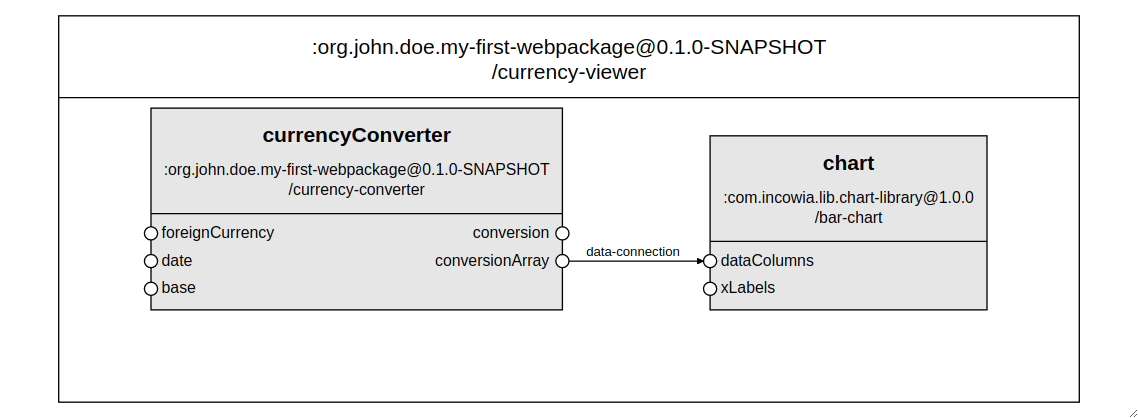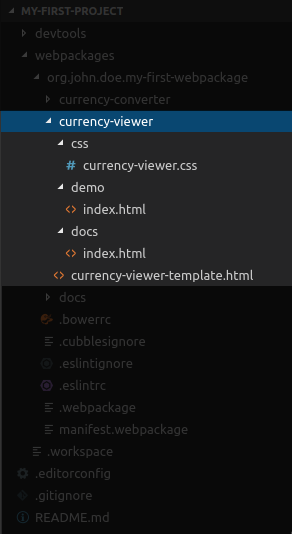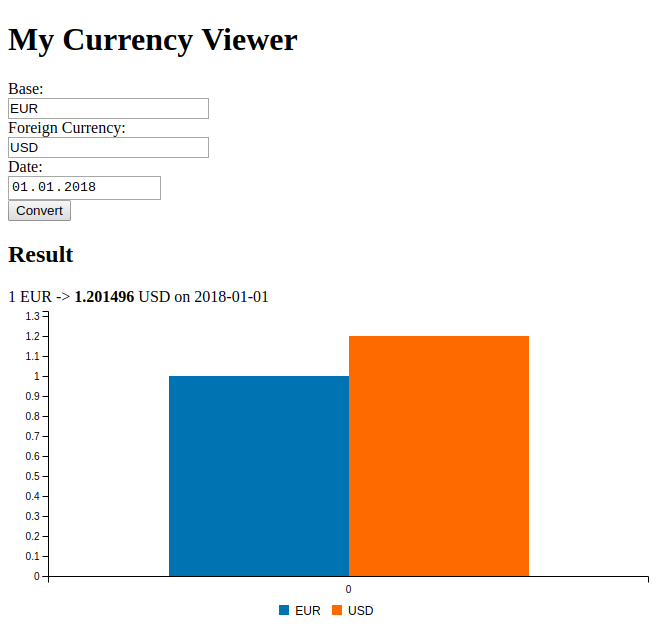Create a compound component
Purpose
To demonstrate how to create a compound component using the Coder Developer Tools (CDT).
Prerequisites
The currency-converter elementary component should be created already.
Creating the currency-viewer Compound Component
We will create a compound component called currency-viewer. This compound will use a chart to display the conversion calculated by the currency-converter elementary.
Members description
The currency-viewer comprises the following members:
| Member Id | Description | Artifact Id | Webpackage Id |
|---|---|---|---|
| currencyConverter | Component to calculate conversions between two currencies at a certain date. | currency-converter | "this" |
| chart | Component to visualise the currency conversion data from the currencyCoverter component using a bar chart. | bar-chart | com.incowia.lib.chart-library@1.0.0 |
Dataflow of the compound
The dataflow of this compound is shown below:

Creation
Our compound component will be created within the same webpackage where you created your currency-converter elementary.
First, run the following Grunt task from DevTools in the bash (Make sure you are located in your devtools folder):
grunt +webpackage-createCompound
Second, you should provide a name and, if you want, a description for the component. In our case, it should be as follows:
- Name: currency-viewer.
- Description: Component to display currency differences in a bar-chart.
If everything is okay, you will get the following message in the bash:
Done, without errors.
The manifest file is modified automatically to include the new compound component. Also, a folder with the name you specified for the component is created. The folder contains a simple structure as follows.

Extending the currency-converter component
We will use a bar chart to display the conversion calculated by the currency-converter. To aim that we will use an elementary component called bar-chart. That component has an input slot indicating the data to be displayed as an array. Thus, we need a new output slot for the currency-converter. The new slot will be called conversionArray and should produce an array as follows:
[
["baseCurrencyName", baseCurrencyValue],
["targetCurrencyName", targetCurrencyValue],
]
// For instance: [["EUR", 1], ["USD", 1.162149]]
To aim that, we need to add a new slot definition to the currency-converter elementary in the manifest.webpackage file:
// ...
"elementaryComponents": [
{
"artifactId": "currency-converter",
// ...
"slots": [
// ...
{
"slotId": "conversionArray",
"type": "array",
"direction": [
"output"
]
}
]
}
],
// ...
Then, we need to set the value of the conversionArray slot when the conversion is calculated. In the currency-converter.js locate the sendQuery function and specifically the following code:
// ...
sendQuery: function () {
// ...
// Update the Cubbles component model slots using the setters
var converted = data[conversionKey]['val'][queryDate];
self.setConversion(converted);
// ...
}
// ...
Below that code, you should add the following line to set the value of our new slot:
self.setConversionArray([[self.getBase(), 1],[self.getForeignCurrency(), converted]]);
Now we can continue developing our compound component.
Specify the Compound configuration in the Manifest File
We should modify the manifest.webpackage file again to set up the compound component. To support a compound you have to specify the member components and the connections between their slots. As you can see in the dataflow picture above, our compound has two members, the currency-converter and the bar-chart component. The compound has a connection identified as data-connection.
The dependencies section
To have the resources of the members available, we need to define two dependencies to be loaded at runtime:
currency-converter
- webpackageId: it is not necessary since the currency-converter implementation is within the same webpackage.
- artifactId: currency-converter.
bar-chart
- webpackageId:
com.incowia.lib.chart-library@01.0.0, as thebar-chartartifact resides within another webpackage. Thus, we should specify the name and version of this webpackage. - artifactId: bar-chart.
Note that the
com.incowia.lib.chart-library@01.0.0is already available in the shared store of the Cubbles platform.
The dependencies property of the currency-viewer should look as follows:
// ...
"compoundComponents": [
{
"artifactId": "currency-viewer",
// ...
"dependencies": [
{
"artifactId": "currency-converter"
},
{
"webpackageId": "com.incowia.lib.chart-library@1.0.0",
"artifactId": "bar-chart"
}
],
}
],
// ...
The slots section
Since our compound doesn't expose any member-slots, just remove the pre-generated slots definition.
The members section
Now, we need to add the members that belong to our compound as follows:
// ...
"compoundComponents": [
{
"artifactId": "currency-viewer",
// ...
"members": [
{
"memberId": "currencyConverter",
"artifactId": "currency-converter"
},
{
"memberId": "chart",
"artifactId": "bar-chart"
}
],
}
],
// ...
Note that both members were included as dependencies. Otherwise, the compound component wouldn't be able to identify them.
By default, each member will be rendered as a direct child node of the compound in the order in which each member was defined above. However, if you want to render the compound members in a particular way or add other HTML elements, you can provide a custom HTML template. The following is an example of a template for the currency-viewer component. To aim that, you should edit the currency-viewer-template.html file. Add the following code to your template:
<template id="currency-viewer">
<h1>My Currency Viewer</h1>
<currency-converter member-id-ref="currencyConverter"></currency-converter>
<bar-chart member-id-ref="chart"></bar-chart>
</template>
Be sure that the id attribute of the template is equal to the artifactId of the compound component. The member components are added as HTML tags whose member-id-ref attribute is equal to its memberId in the manifest.webpackage.
Moreover, to make the template available, you should add it as a resource in the compound component in the manifest.webpackage file as follows.
// ...
"compoundComponents": [
{
"artifactId": "currency-viewer",
// ...
"resources": [
"css/currency-viewer.css",
"currency-viewer-template.html"
],
}
],
// ...
Note that you can modify the css/currency-viewer.css file (automatically generated) to style your component.
The connections section
A connection defines the data to be transferred between 2 slots each from one member. To set up a connection you need to edit the connections array of the compound component in the manifest.webpackage. Add the following code to your manifest to include the data-connection connection to the currency-viewer-compound:
// ...
"compoundComponents": [
{
"artifactId": "currency-viewer",
// ...
"connections": [
{
"connectionId": "data-connection",
"source": {
"memberIdRef": "currencyConverter",
"slot": "conversionArray"
},
"destination": {
"memberIdRef": "chart",
"slot": "dataColumns"
}
}
],
// ...
}
],
// ...
The inits section
The inits property of a compound allows setting an initial value to the slots of the compound component being defined, or to the slots of its members. To read more about compound components initialisation check this.
We won't initialise any slot for the purpose of this tutorial.
Check your first Compound Component
Now you can check the generated demo of the component performing the following steps:
- Start the embedded webserver using the
+startWebservergrunt task available in the Coder Developer Tools (CDT). - Your default browser will start.
- Navigate to: http://localhost:8282/[webpackage-name]/currency-viewer/demo/
Note that [webpackage-name] should be replaced by the name of your current webpackage.
It should look as follows:

You can also check the results at the online demo.
